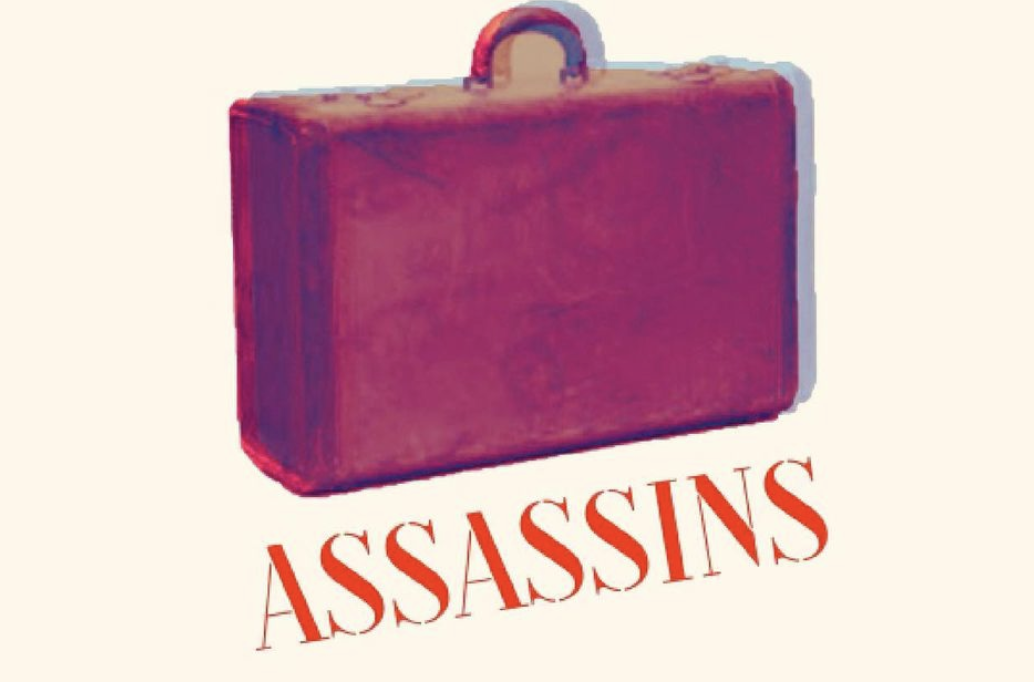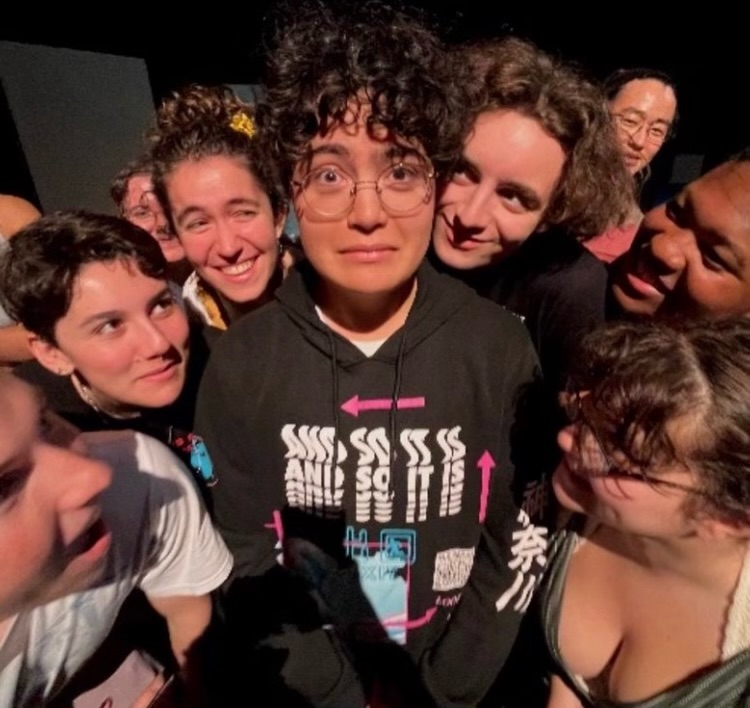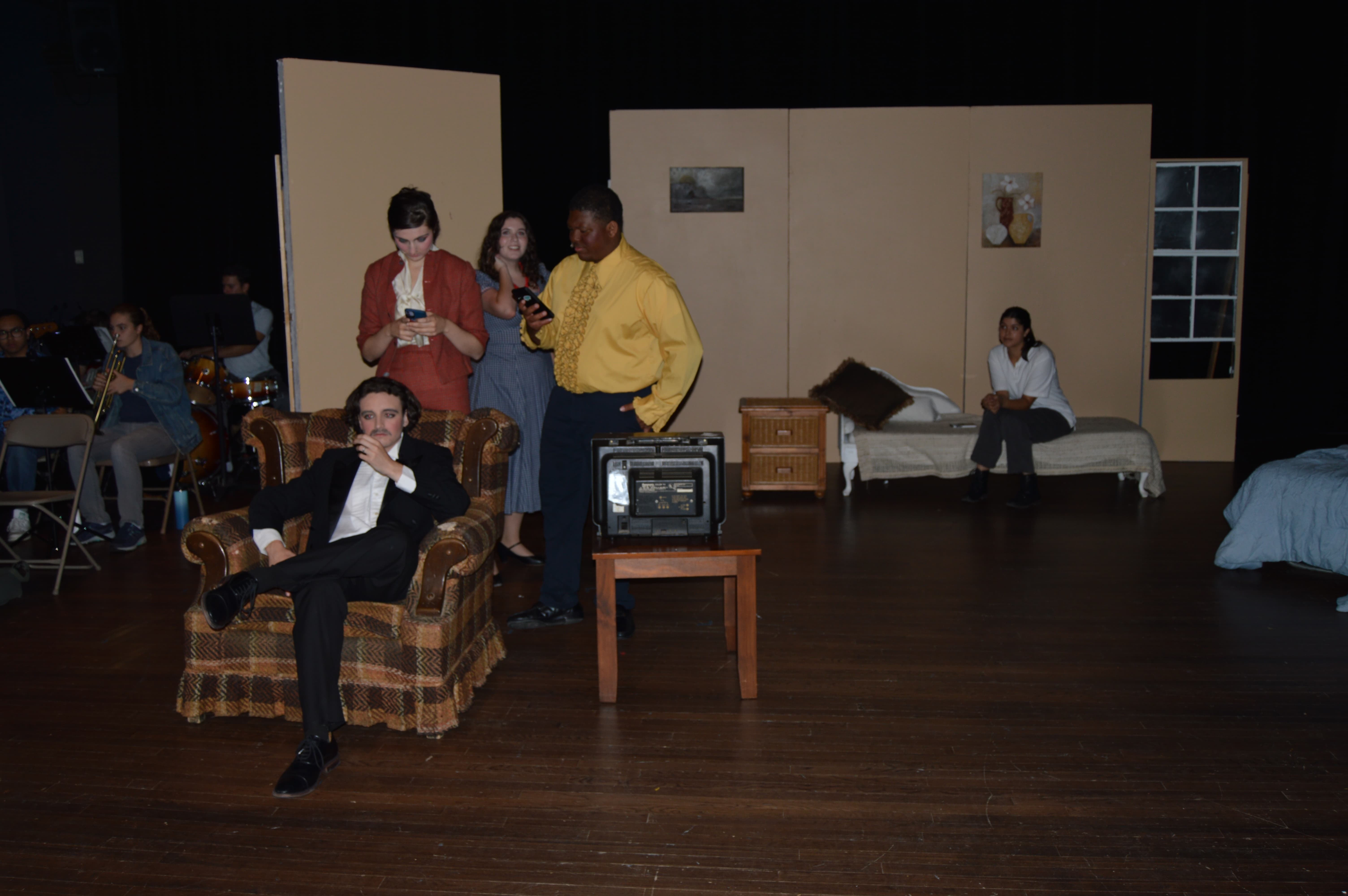
c/o Lily-Edelman ’24
“Assassins,” a 1990 musical with music by Stephen Sondheim and a book written by John Weidman, went up in the Patricelli ’92 Theater last week on Nov. 3 at 7 p.m., Nov. 4 at 7 p.m., and Nov. 5 at 2 p.m. and 8 p.m. The show takes the audience through the various assassination attempts, successful and not, made on U.S. presidents throughout American history, as well as the assassins behind them, like John Wilkes Booth and Lee Harvey Oswald. Though the play covers a rather dark topic, there are many satirical and funny moments. Often, the audience giggled at a character’s exaggerated actions or facial expressions.
Significantly, this was the first musical performed in the ’92 Theater since Fall 2019. “Assassins” sold out in a matter of days, and eager audience members packed into the theater to watch. As I walked in, I heard the live orchestra warming up and excited chatter all around me. As we took our seats, my friend and I turned to each other and started talking about the set. From the audience’s point of view, there was an armchair on the left side of the stage, close to the orchestra, and in my opinion, it looked rather comfy. A longer couch was placed in the center of the stage, close to the back wall. To the right side of the couch was a bed placed diagonally facing the audience. Beyond the bed was a simple bathroom setup, and scattered around the furniture were cream-colored walls and an open window behind the couch. The setup generally felt homey, which seemed contradictory knowing the overall premise of the play.
After some pre-show announcements, the lights dimmed and the orchestra began playing. The opening number, entitled “Everybody’s Got the Right,” depicted John Wilkes Booth (Kieran Gettel-Gilmartin ’25) selling briefcases to each assassin. Towards the end of the song, we saw them line up at the front of the stage with their briefcases, put them down, open them, pull out jackets and accessories (one person pulled out a Santa hat!) and lastly, pull their guns out and hold them close. This set the show up nicely, as the audience now knew who the assassins were and could then follow their storylines over the course of the play.
I really loved the juxtapositions between characters within individual scenes throughout the whole show. “The Ballad of Czolgosz” detailed the assassination of President William McKinley by anarchist Leon Czolgosz (Junu Lee ’25). In the song, several characters were waiting to meet President McKinley and were, obviously, quite excited at the prospect. The choreography incorporated energetic shoulder shrugs and stepping in place along to the beat, in addition to the characters eagerly whispering to each other. This lively scene was starkly contrasted by Czolgosz standing still in the middle of the crowd with a stern expression on his face. At the end of the song, all of the characters moved into a single-file line with Czolgosz at the back. Each person came forward and mimed greeting the president. Then Czolgosz stepped forward, removed his gun from his handkerchief, and shot. Everyone else, realizing what just happened, ran away screaming.
Juxtaposition was also a central aspect of the relationship between Booth and the Balladeer, the narrator, who later transformed into Lee Harvey Oswald (Drew Weddig ’24). During “The Ballad of Booth,” the second song in the musical, the Balladeer talked about Booth’s decision to assassinate Abraham Lincoln and chastised him, in a way, by repeating the lyric “Why did you do it Johnny?” followed by other lyrics, like “nobody agrees,” and “throw it all away.” In contrast, Booth was shown in a physically and mentally vulnerable place. He went into hiding after the assassination but was found, and he made the decision to kill himself. In this scene, the Balladeer was shown as the character with power, criticizing and standing over the kneeling Booth.

c/o Assassins Team
However, in one of the most powerful images in the show, a red light was cast on both Booth and the Balladeer, implying that both characters ended up going down the same path. Their relationship came full circle at the end of the play during “Another National Anthem” and “Scene 16,” where all of the assassins appeared and attempted to pressure the Balladeer into becoming one of them. They crowded around the Balladeer and jostled him around, screaming their reasons for attempting assassination. This moment of tension began with Booth cornering the Balladeer. At one point, he snapped his fingers, and we heard the sound of a radio show host talking about President John F. Kennedy’s motorcade rounding the corner, with people cheering and holding banners for him. Booth snapped his fingers again and the sound stopped. After these intense interactions, the Balladeer walked offstage for a brief moment, then returned, fully transformed into Oswald. Booth presented a rifle to him. At first, Oswald hesitated, but then he took the rifle, slowly moved to the window, and took his aim as the rest of the assassins watched him. This switch of power was such a captivating moment, showcasing how easy it was for Booth and the assassins to manipulate the Balladeer/Oswald.
I spoke to Weddig, asking him what this transition was like on stage.
“We kind of made it so that I was slowly getting indoctrinated into the mindset of the assassins,” Weddig said. “So in ‘The Ballad of Guiteau,’ at the end, I’m a little crazy because I’m actually starting to believe in it. By the end of ‘Another National Anthem,’ I barely believe myself because everyone is screaming in my ear.”
The finale song, “Everybody’s Got the Right (Reprise),” depicts the assassins rejoining each other in the same line across the stage they formed at the beginning. They placed their jackets or Santa hats back in their briefcases, but, curiously, kept their guns in their hands.
After watching “Assassins,” I sat down with the co-directors, Sadie Goldstein ’24 and Miranda Simon ’24, to chat about the show.
When asked how they picked this musical, they spoke fondly about bonding over the show when they first met.
“I guess it was spring of last year, Goldstein said. “I walked into our friend’s room and was like, ‘I want to direct a musical,’ and Miranda said, ‘How can I help?’ and that was the start of it.”
“‘Assassins’ is something that both Sadie and I have been fans of for a very long time,” Simon added. “I’ve been a fan of the show at least since middle school. It was one of the first things that Sadie and I had a shared interest in, and we thought it would be fun to take it and put it onstage.”
They also spoke about their process in the rehearsal room, emphasizing how they each were able to bring their strengths to the project. While Goldstein and Simon staged each scene together, the two had separate focuses.
Simon concentrated on the emotional states and historical backgrounds of the characters and the actors playing them.
“It’s an emotionally taxing show for some characters, a lot of emotions getting thrown around, and it’s important to do that safely for the actors and do that in a way that they are able to sustain energy throughout the show,” Simon said. “[Also,] really finding the deeper meaning of the scenes and how to convey that through acting,”
Goldstein’s approach centered on the physicality of the actors and their characters.

c/o Assassins Team
“When I’m staging something, I’m way more focused on physicality and how can we approach a character from how they stand or how they hold themselves.” Goldstein added. “For a lot of these characters, they’re caricatures of real people, so the way in which they hold themselves is a big deal.”
I also spoke to some of the other cast members about what it was like to play real people in history. Charlotte George ’24, who played activist and writer Emma Goldman, detailed what it was like learning about her character in the context of the show.
“It was really cool to learn about my character and play [someone] who was a real person and connect it to the show,” George said. “These characters were real people. They had a history, which was an interesting part of the show [even though] it is a dramatized version of their lives.”
Lincoln Turner ’25, who played Charles Guiteau, the assassin of President James Garfield, detailed the differences between him and his character.
“Honestly, it was trippy at first putting my voice in that bass ‘Gaston’ pocket, donning my costume excellently selected by [costume designers] Greta [Armbrust ’25] and Celeste [Borletti ’25], and putting on my stage makeup,” Turner wrote in an email to The Argus. “It was an experience. But one I’m grateful for. Guiteau is for lack of a better word an asshole so having him be so different from me inside and out was important for me.”
The talent displayed in “Assassins,” was phenomenal. From the acting to the singing to the light and sound effects, each piece of the show came together beautifully. I was on the edge of my seat throughout and was in awe of how powerful everyone’s performance was. Even a week later, I still find myself with all of the songs stuck in my head.
Sabrina Ladiwala can be reached at sladiwala@wesleyan.edu.